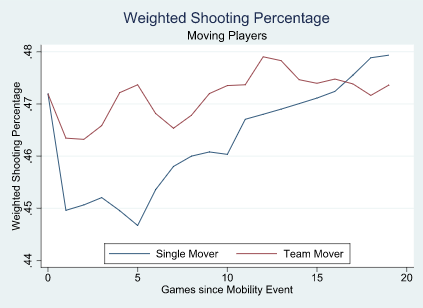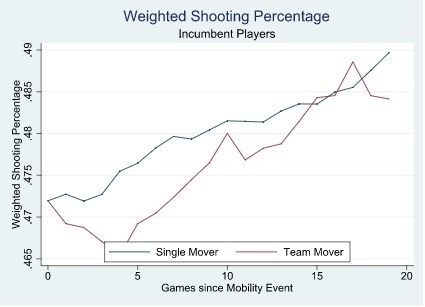Sports Reference Blog
The Impact of Multi-Player Trades on Performance in the NBA
Posted by Mike Lynch on April 27, 2015
Sometimes SR data finds its way into academic journals. Here's a summary Benjamin Campbell has written up on some of his findings about post-trade player performance:
"Although NBA GMs make mid-season trades for multiple reasons, one frequent objective is to improve
the short-term performance of the team. Since the rim is 10 feet from the floor everywhere from Hinkle
Fieldhouse to the Staples Center and the rules are the same everywhere, this seems to be a good
strategy. However, given the interdependent nature of basketball, trades present a challenge to short-
term performance because they disrupt the ability of players to productively play together. It is through
experience and time together that players can learn how to best play together, thus there is a learning
curve whenever a trade occurs. This learning curve impacts both the players joining a new team and the
incumbent players on that team that now have to learn to play with new players.
The learning curve for players to adjust to a trade is impacted by the size of a trade. For example, when
Raef LaFrentz, Nick van Exel, Avery Johnson, and Tariq Abdul-Wahad moved together from Denver to
Dallas in exchange for three players on February 21, 2002, they had less of a learning curve than a single
mover because they already knew how best to play with each other. However, their new teammates in
Dallas had a steeper learning curve because the incumbent players have to learn the idiosyncrasies of
four new, already coordinated teammates.
Using data from basketball-reference.com, a recent academic paper explores the learning curve
associated with single and multi-player trades on player performance over time. The authors find that
players who move from one team to another by themselves lose 2.3 percentage points from their true
shooting percentage on average, and take about 20 games to get back to their previous performance.
The true shooting percentage of players who move as part of a multi-player trade is not significantly
impacted. However, the reverse is true for incumbent players: players who are joined by one new
teammate experience no reduction in team shooting percentage, but players who are joined by multiple
teammates at the same time do experience a small (but statistically insignificant) reduction in true
shooting percentage. These effects are similar for both starters and little-used players alike.
The authors also show that moving with other players has a substantially larger positive effect on
movers’ individual performance when moving to teams with a losing record than when moving to teams
with a winning record. This suggests that it is easier for players moving together to import their existing
relationships in to low-performing teams than in to high-performing teams.
Together, the results highlight the double-edged sword of trading to improve the short-term
performance of a team. Trades may improve short-term performance by bringing in better players
and/or players that will eventually fit the team better. However, bringing in new players is disruptive to
all players on the team which erodes the short-term benefits of the trade.
For more information, see “Resetting the Shot Clock: The effect of comobility on human capital,” by
Benjamin Campbell, Brian Saxton, and Preeta Banerjee, which appeared in the February 2014 issue of
the Journal of Management."



The paper is paywalled, but people who have access through an academic library can see it .
I'm terrible at HTML; the paper is at http://jom.sagepub.com/content/40/2/531.